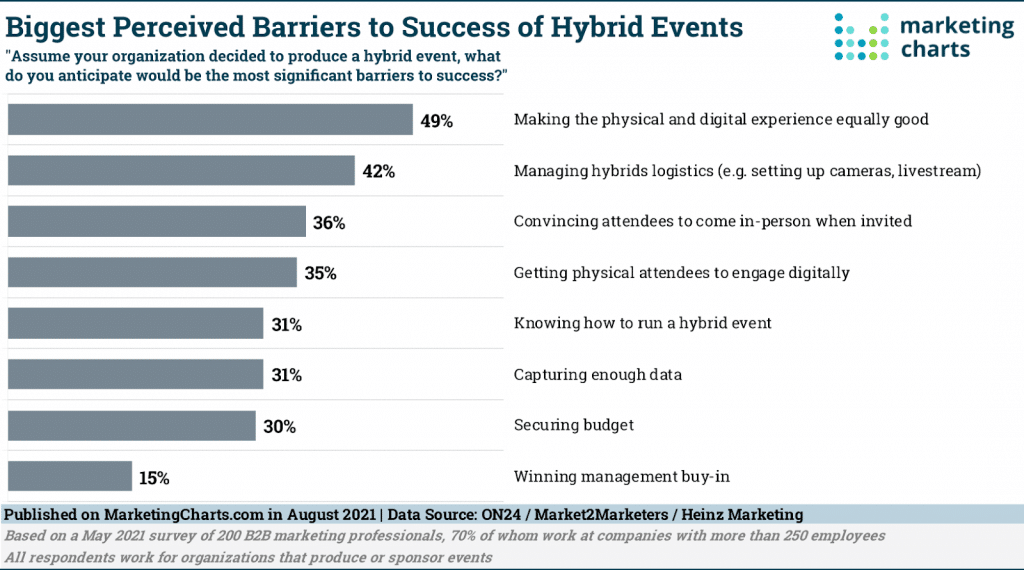The Covid-19 pandemic has gotten in the way of many businesses.
Companies have had to adapt to the social distancing, create forms of remote working, and accelerate their Digital Transformation.
While some of those changes are already behind us, others will be around for some time. This is the case with hybrid events.
As we learn how to fight Covid-19, the restrictions imposed by the pandemic, in some locations, are easing. So, many events are being held in person again, while some people are still wary of returning to “normalcy”.
For this reason, many events are planned in hybrid form, that is, with characteristics of both online and face-to-face events. But will this be the reality from now on? How do we prepare for this type of event?
These are the questions we will analyze in this article. We will address the following points:
- What is a Hybrid Event?
- Why Hold Hybrid Events? Understand 6 Key Benefits
- Why Will Hybrid Events be a Reality in 2022?
- How to Hold Hybrid Events?
- Wrap Up
What is a Hybrid Event?
A hybrid event combines characteristics of both in-person and virtual events.
It can have different arrangements, but, in practice, the main hybrid event model is held in person with simultaneous broadcast and online interactions.
These events can be music concerts, theater performances, sports games, but, in this article, we refer mostly to business events, such as lectures, courses, seminars, congresses, fairs, and conferences.
Traditionally, this type of event has always been face-to-face. In them, it is possible to attend the speeches of specialists, do networking, meet partners and suppliers, and get up to date on the market.
Thanks to technology, a few years ago, they were transformed into online events, with virtual courses and webinars, for example.
During the Covid-19 pandemic, many companies migrated to the online sphere to make it possible to hold business events and maintain their schedule in the context of the social distance that the coronavirus imposed.
When face-to-face activities resumed, companies started to adopt a hybrid model of events, which counted both on face-to-face activities and the virtual participation of the public.
Once again, thanks to technology, it is possible to adopt different models to adapt to other realities.
However, it is also necessary to understand other characteristics of these events. Some people may think that it is enough to make available recorded content after the lectures or do a live broadcast. But this is not entirely true.
A hybrid event needs to be well planned and rely on technology and equipment.
The online transmission and the remote experience must have the same quality as the live experience so that all participants can engage with the event.
You’ll see tips for creating an unforgettable hybrid event later in this article.
Why Hold Hybrid Events? Understand 6 Key Benefits
Even outside the pandemic context, hybrid events have advantages, giving proof that they can continue to be adopted in the coming years.
Here are the benefits for your company when holding hybrid events:
1. Broader reach
Hybrid events have the potential to attract a larger number of attendees. After all, they have no limits when it comes to reaching people.
You can serve those who like to attend events in person and those who are not in the same city, cannot commute, feel insecure about crowds, or simply prefer to participate remotely.
2. Attractiveness for sponsors
The broader range of attendees makes the event more attractive to partners, supporters, and sponsors.
For them, it is also valuable to expose their brand to more people and connect with a larger number of potential customers.
In addition, hybrid events can offer more innovative and attractive forms of sponsorship and relationship between the public and sponsors.
This goes beyond the mere exposure of the brand and integrates online interactions in their actions.
3. Better use of content
Hybrid events can make better use of the content than face-to-face events.
Suppose you are going to record all lectures and presentations, for example. In that case, you can offer a package of access to the recording after the event and monetize this content on demand.
In addition, that content can turn into social media posts and materials to share with your audience on digital channels.
In other words, it becomes quality content to nurture leads in your sales funnel.
So, while in-person events have a day and time to end, the output of hybrids can still expand long after.
4. Safety for the audience
Hybrid events also offer more security for those not comfortable sharing enclosed spaces with other attendees.
In face-to-face events, these people would simply not participate.
Hybrid events allow them to enjoy all the content without being exposed to the risks of coronavirus and other diseases.
5. Better return on investment
Hybrid events offer a better return on investment (ROI), mainly due to their greater reach and scalability.
You can reach more people and earn more from sponsors without investing more.
In addition, you can reduce your face-to-face event costs by working with smaller venues since you won’t need to host every attendee in person.
6. Security in face of eventualities
No one expected to experience a pandemic in 2019. But this was just one of many eventualities that could happen and jeopardize your schedule.
Problems with public transport, storms, or even another virus of global scale can make it difficult again for your audience to attend.
So, planning a face-to-face event without the infrastructure of an online broadcast can be risky.
On the other hand, when you plan a hybrid event, you have the assurance that it can take place over the internet if any of these problems occur.
Why Will Hybrid Events be a Reality in 2022?
In the context of the Covid-19 pandemic, especially as face-to-face activities begin to happen again, hybrid events have become the solution to engage the audience.
Since many people feel insecure about sharing enclosed spaces with other participants, the idea is to offer them the option of following the event without leaving home.
But, as we have seen, this type of event is likely to be used in the future even if the pandemic is over for good. Therefore, 2022 promises to be the year of hybrid events.
According to The Future of Events Report in 2020, 3 out of 4 respondents (74%) said they had a hybrid event planned for the next 12 months — a higher percentage than face-to-face only events (70%).
Furthermore, 95% agreed that the hybrid approach will be widely used in the coming years.
So, the events industry and companies planning to go digital in this area need to get ready.
If this market already had to reinvent itself during the Covid-19 pandemic, hybrid events will likely mobilize new strategies to offer the best experience to attendees.
How to Hold Hybrid Events?
Whether in physical or online environments, people seek valuable experiences.
With life becoming increasingly faster, they want to make sure they focus their time on something worthy.
The hybrid approach must meet these expectations and requirements.
Despite this, few companies have experience with hybrid events. Therefore, there are still many challenges to overcome in order to please attendees and achieve good results.
In the next section, you’ll find tips on dealing with this type of event. Check them out!
1. Plan an event that is hybrid from the beginning
Some companies fall into the trap of planning a face-to-face event and only include a live broadcast in the last moments.
In general, this causes problems because a hybrid event requires planning actions beyond the live transmissions and a series of precautions to run smoothly.
Without this, the experience of remote participants tends to be jeopardized.
Therefore, think about the hybrid approach from the beginning of the event planning.
This way, you can design an event entirely focused on your persona and consider all the details to impress the participants.
2. Offer a valuable experience
One of the main problems in planning hybrid events is neglecting the remote attendee experience.
Companies still often focus on the face-to-face event, while the online event boils down to a live broadcast, often with audio and connection issues.
The Future of Events Report showed that creating an equally good physical and digital experience for attendees is the biggest challenge for hybrid events.
While this is a significant barrier, it will make your event different and delightful.
So, think of attendees in the same way regardless of how they attend your event. They should feel well taken care of, interested in the content, and involved with interaction possibilities.
This way, everyone feels engaged and valued.

3. Create online interaction experiences
Remote attendees should also feel integrated into the event, not just as an isolated audience. So, think of ways for the online audience to interact with the event.
But don’t leave out in-person attendees. They also want differentiated experiences that go beyond a passive audience.
So online interactions can also integrate those who are live at the event.
You can offer, for example, an event platform or application that promotes questions, polls, quizzes, chats, gamification, and other interactive content.
Also, since networking is an essential element of events, think about how to integrate in-person and remote attendees so that they can interact.
4. Offer new forms of sponsorship
Besides the attendees, think about the experience of sponsors.
They can also take advantage of new sponsorship possibilities that generate brand exposure and audience engagement.
For example, if you use an app for the event, you can offer branding spaces on these platforms.
In addition, hybrid events allow sponsors to promote interactions with attendees and nurture a relationship with them after the event.
5. Have a good infrastructure for transmission
The technology used to transmit the event online must be efficient. Do not rely solely on your cell phone to broadcast your company’s event.
Cameras, microphones, a sound mixer, lighting, and a stable internet connection are essential to ensure image, sound, and transmission quality.
You will also need a live streaming platform. In some cases, this is integrated with an event platform, or you can broadcast via YouTube or social networks if they are relevant to your strategy.
Also, don’t think that one person can do all of this. It is usually necessary to have a professional video production team with experience with this kind of event and the equipment.
6. Test all equipment and tools
Before holding the event, make sure that everything is working properly. Test the sound and video equipment, see if the connection is well established and if the platforms are integrated.
Of course, unforeseen events can happen. But a good review of all the equipment and tools reduces the chances of problems.
In any case, always try to have a Plan B to overcome these unexpected challenges and not jeopardize the experience of the event participants.
Wrap Up
Adapting to hybrid events is a necessity for businesses today.
The technology of the event and live streaming industry already allows you to create valuable experiences with this type of event and meet the increasingly demanding expectations of attendees.
But to do this, new approaches need to be adopted in the delivery of business events.
If the Covid-19 pandemic has forced many companies to accelerate their Digital Transformation, it is time to seize the opportunities that this new reality offers.
Now that you know all about hybrid events, how about finding out how to use live events in your ABM strategy? Check out our article about this topic!









